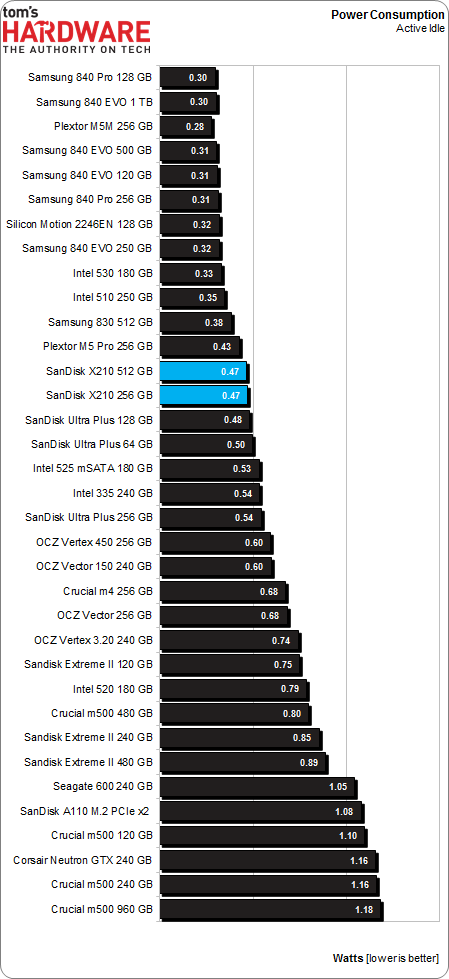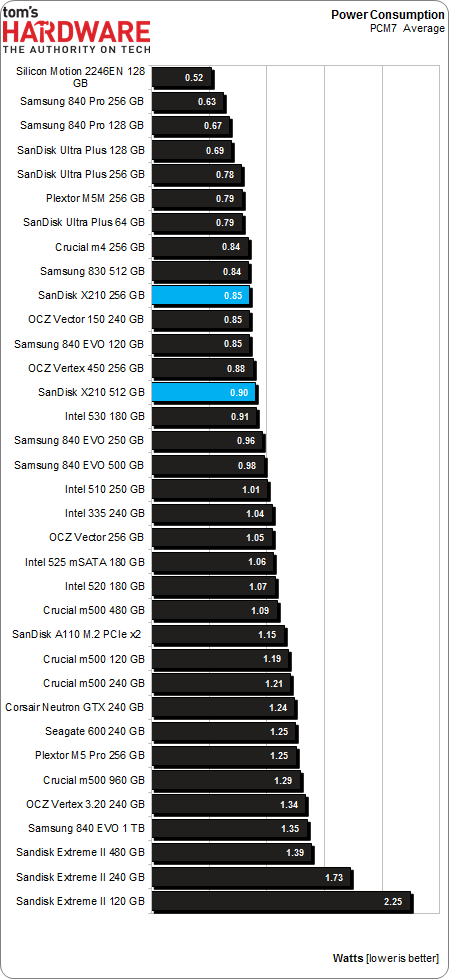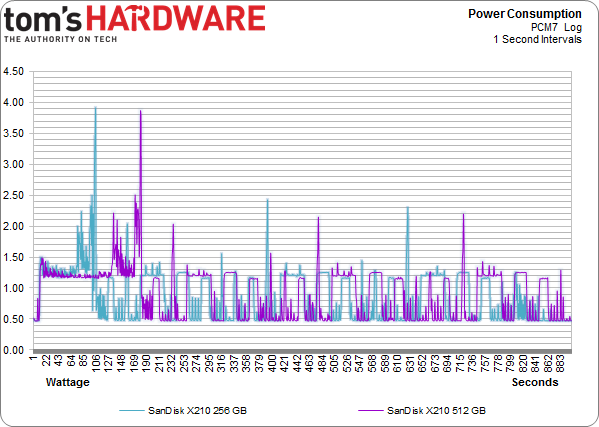SanDisk X210 256 And 512 GB: Enthusiast Speed; OEM Reliability
SanDisk's X210 SSD is both an OEM drive for major vendors and an aftermarket product for the enthusiast world. Having passed a gauntlet of validation tests, can it break into the consumer space as a true alternative to the quickest power user products?
Results: Power Consumption
Idle Power Consumption
Active idle power numbers are critical, especially when it comes to their impact on mobile platforms. Idle means different things on different systems, though. Pretty much every drive we're testing is capable of one or more low-power states, up to and including DevSleep, a part of the SATA 3.2 host specification. And although DevSleep requires a capable SSD and a compatible platform, enabling it takes power consumption down to a tiny figure. This is why we test active idle; it's easy to identify, and is still where SSDs spend most of their time.
The X210 fares well in this metric partly as a result of its Marvell 88SS9187 controller. Registering 0.47 W, both SSD valiantly charge at the most power-friendly drives in our comparison, even if they fall a bit short. But given the environments these SSDs will drop into, one-tenth of a watt isn't going to make or break the efficiency measurement of an entry-level server or high-end laptop.
PCMark 7 Average Power Consumption
If we log power consumption through a workload, even a relatively heavy one, we see that average draw is still pretty close to the idle numbers. Maximum power may spike fiercely, but the usage seen during a PCMark 7 run is pretty light. You can see the drives fall back down to the idle "floor" between peaks of varying intensity.
Averaged out over a complete PCMark 7 run, the 512 GB X210 uses 0.9 W, while the 256 GB model settles in at 0.85 W. That puts SanDisk's drives around the same level as Samsung's 840 EVOs and OCZ's more recent offerings.
Let's plot the log data for more detail:
The distances between peaks comes down to writing used LBA spaces. Basically, PCMark 7 is formatting the addresses the component traces will use, which takes longer on the 512 GB X210 than on the 256 GB version. That's why the smaller drive gets started first.
Get Tom's Hardware's best news and in-depth reviews, straight to your inbox.
As far as power consumption goes, there really isn't much variance between the two. Both hit the same idle floor and demonstrate similar peak figures. The higher-capacity SSD simply uses a little more power.
Maximum Observed Power Consumption
Unfortunately, that's enough to put the X210s toward the bottom of the chart in maximum observed power consumption. These drives could use more power in certain workloads or under specific conditions, but this is the highest we saw in our own test suite.
Current page: Results: Power Consumption
Prev Page Results: File Copy Performance With Robocopy Next Page TRIM Testing: Our Suite Evolves Yet Again-
TeraMedia Is the warranty 5 years or 3? Last page says one thing, an early page says another.Decent review, decent drives. Has THG considered doing something similar to what the car mags do, where they take certain products and use them for a year? It would be great to capture that kind of longer-term info on certain types of products, especially the kind that wear out (ODDs, fans, cases, HDDs, SSDs, etc.).Reply -
Quarkzquarkz What about Samsung SSD pro 512GB? I bought 2 of these and on that chart is only 128 and 256GBReply -
vmem @vertexxthere isn't anything particularly exciting about Kaveri going by Anand's review. I shall want for the A10 version with higher clocksReply -
smeezekitty MLC with 5k write endurance!And affordable and fast?We may very well have a new solid contender in the SSD worldReply -
RedJaron I agree with Chris. I don't need the fastest bench speeds in a SSD. Most models now are very fast and the user won't see the performance difference. I want reliability and longevity. Looks like this is a smart choice for any new builder.Reply -
jake_westmorley Can we PLEASE have some normal graphs for once? The graph on page 5 in stupid 3D is so bad it's comical. The "perspective" effect completely screws with the data. This has zero added value and is almost as bad as still using clipart.Reply -
Duff165 I find it hard to believe that the author has had "literally dozens of SSd's die" on him over the years. This would suggest that many systems have contributed to the demise of many of the SSD's being used, which seems somewhat outlandish. Just the cost factor involved in the purchase of so many SSD's and then having over a dozen of them fail, supposedly also from various companies, since if they were all from the same company it would not really be conducive to good sales. One, or maybe two I could live with, but dozens? No.Reply



